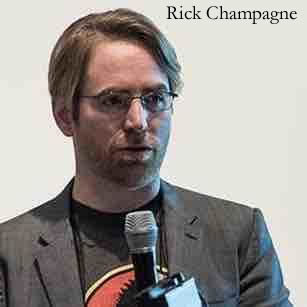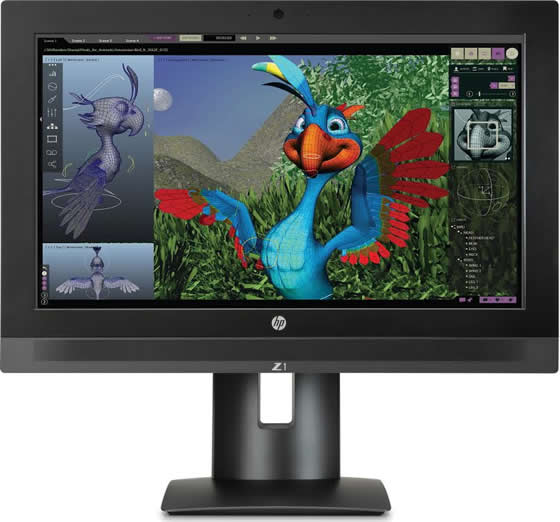 HP Bridging The Borders Award, offered by Cinema Without Borders at Palm Springs International film Festival in early January is now a well-recognized award in the film community around the world. CWB will be a running a series of articles about this award and sponsor of the ward, HP Workstation department.
HP Bridging The Borders Award, offered by Cinema Without Borders at Palm Springs International film Festival in early January is now a well-recognized award in the film community around the world. CWB will be a running a series of articles about this award and sponsor of the ward, HP Workstation department.
For the first article we interviewed HP’s Rick Champagne .
Rick Champagne is the Worldwide Media & Entertainment Segment Manager for HP Z Workstation Technologies. Working closely with customers and industry partners, Rick guides HP’s strategy and business development within the film, television, broadcast, and games industries. With a long history of managing products such as Autodesk Mudbox, Softimage, and the 3ds Max and Maya Entertainment Creation Suites, Rick has been in the service of Artists and other Creative Professionals for nearly two decades.
Rick spends much of his personal time in his technological and creative pursuits and holds a Master’s in Business Administration.
Bijan Tehrani: HP Workstation are now the most important player in the Hollywood film industry, a realm that for a long time belonged to other companies, how has this change come about?
Rick Champagne: There are a number of important technology players that are helping the film industry bring their incredible visions to life, and many of us work together on that task. HP and Intel for example, have been a backbone to many of the industry’s top artists and filmmakers – something that we take great pride in. Our success in the industry has been in part driven by our relentless focus on creating ultra-reliable solutions that deliver the kind of performance necessary to allow filmmakers to focus on what makes them most successful. We also have dedicated resources who serve the film industry and we look at the entire film production pipeline when developing solutions. Being workflow-oriented allows us to find ways of innovating and optimizing around our customer’s greatest needs. We also work very closely with software providers like Autodesk, Adobe, Avid, and The Foundry to test and certify Z Workstations which helps us maintain the highest level of quality for our customers. The last area worth noting is our teams focused on other industries like architecture, aerospace, defense, and healthcare. This is important to note because reliability in some of these segments is paramount. NASA for instance, recently delivered a payload of HP ZBook mobile workstations to the International Space Station to assist with everything from entertainment and communications to managing health systems for the Astronauts on board the ISS.

BT: Please tell us about today’s involvement of HP in major motion picture productions?
RC: HP Z Workstations can be found in nearly every major part of the film production pipeline – from concept art and storyboarding, to previz, mocap, modeling, rigging, animation, texturing, lighting, rendering, compositing, editing, color grading, conforming, transcoding, and the list goes on and on. Many major motion pictures have been touched by HP Z Workstations and our color critical HP DreamColor displays. While we can’t disclose all of these projects, companies such as DreamWorks Animation and Weta Digital have publicly shared their stories, and even assisted in the development of DreamColor technology.
BT: Is there a way for filmmakers to communicate their special demands for tools and technology with the HP Workstation development team globally?
RC: Yes. HP has a longstanding Film Advisory Council that convenes annually in London and in Los Angeles. We share our long term roadmaps with our Council Members and use their valuable feedback to change or refine our plans to best meet their needs. We also have the New Council that has been meeting in different cities across the world to bring together studios of all sizes who are innovating in the industry. The New Council is a great way for HP to interact with our customers in an open technology forum and discuss new and emerging technologies such as augmented and virtual reality. Lastly, we also actively collect feedback directly from customers through site visits and one on one conversations at events. In the end, it’s really about talking to people, understanding and anticipating their needs, and ultimately delivering products that solve real world challenges.
BT: Please tell us about your own approach in dealing with entertainment industry needs and your hopes and dreams for the future of HP Workstations.
RC: As the Worldwide Segment Manager for Media & Entertainment, I directly plan and host our Film Advisory Council. Advisory Councils are not new, but a lot of companies tend to use them for something called “product validation”. My personal approach, and our Product Management team’s approach is to have open, honest conversations with the Council Members and seek their feedback. It sounds obvious, but it’s a very different mindset. When you free yourself from looking for data points to support your ideas and justify what you are doing, you start to actually hear what your customers are telling you. Outside of the Council, I have personally visited over 75 studios worldwide ranging from small post-production facilities to the world’s largest film studios. The goal here is to take our understanding of customer workflows to a level that is much deeper by not only discussing their needs, but also observing the work environment, how systems, displays, and peripherals work together, and how the data flows. By understanding this on a deeper level, we can not only improve the overall production pipeline, but we can also help customers save money by tailoring solutions to their individual needs.
BT: Independent filmmakers have also welcomed the presence of HP in the film industry as the advanced technology offered by HP is also affordable for independent projects, how do you see the position of HP Workstations in that market?
RC: The most valuable asset in any film production is the artist’s time. Our goal is to get completely out of the way of the artist so that they can stay in their flow and get things done faster. When you have a Director or client in the room and they want to see the effect of a change right now, you can’t waste their time watching status bars. If you’re an Independent Filmmaker, your own time is at a premium and limiting your creativity because exploring compute-intensive options is too slow or painful will ultimately cause your work to suffer. HP Z Workstations are designed to take on the most challenging tasks to let you play and help you get your work done on time. HP does offer a range of workstations from the very affordable HP Z240 through to our flagship Z840 Workstation.
BT: HP’s Bridging The Borders Award, sponsored and supported by HP Workstations and offered by Cinema Without Borders at Palm Springs International ShortFest and Palm Springs International Film Festival, that goes to the films that brings people of our world closer together, has been welcomed by US and international filmmakers, how do you see these cultural involvements of HP supporting the film communities?
RC: HP has been working with the Palm Springs Film Festivals and Cinema Without Borders for years now, and we share a similar passion for supporting independent filmmakers in their creative pursuits. Most recently, we’ve been working with Milica Zec and Winslow Porter who are truly bridging the borders by transporting audiences into an active war zone through a short virtual reality film called “Giant”. This powerful film engages viewers in a way that lets them experience the real effect of war and empathize with people in other countries that live through it on a daily basis. HP is a very strong supporter of independent filmmaking, and when you pair our mission with that of Cinema Without Borders, it’s very natural for us to be a part of something so important.

